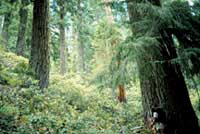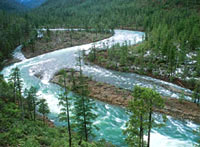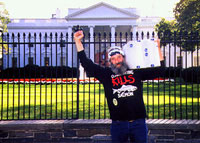Kelpie Wilson is executive director of the Siskiyou Regional Education Project, a grassroots network formed to protect the wild forests and rivers of the Klamath-Siskiyou bioregion in northwest California and southwest Oregon.
Tuesday, 5 Sep 2000
CAVE JUNCTION, Ore.
Well, Grist readers, you have caught me, and the Siskiyou Project, right in the midst of our biggest campaign ever, the quest for a million-acre Siskiyou Wild Rivers National Monument. Stirring things up is nothing new for us — we’ve been in the thick of the ancient forest struggle since the first blockade on Bald Mountain Road back in 1983. But we’ve really done it this time. The loggers, miners, and anti-government types are furious at us for proposing this “land lockup.” Meanwhile, thousands of citizens across the nation have been pouring letters and faxes into the White House, asking, begging, pleading with the administration to do this one last thing for the ancient forests of the Pacific Northwest — create the Siskiyou Wild Rivers National Monument. (Before I go any further, let me tell you how to add your thoughts to the torrent of comment heading to Washington, D.C.: Go to the Siskiyou Wild Rivers website and send a free, instant fax!)

That’s me in the lower right-hand corner.
This picture of me in the ancient forest was taken in the roadless Canyon Creek watershed, saved from logging by 10,000 Siskiyou Project supporters who sent in comment letters back in 1994. (You see, letter writing really does work!) President Clinton’s Northwest Forest Plan placed Canyon Creek in what’s called a Late Successional Reserve. That’s “reserve” not “preserve.” It’s protected, but only as long as the Northwest Forest Plan is in place. And who knows how long that will be? On recent campaign swings through Oregon, both George W. Bush and his running mate Dick Cheney have indicated that they would “fix” the situation here in the Northwest and allow more logging of public lands. Vice President Al Gore says that his administration would protect all the roadless areas from logging. Either way, nothing is certain and this place needs permanent protection — the kind of permanent protection that a national monument provides.

The wild & scenic Illinois River.
Photo: Barbara Ullian.
The Siskiyou is one of those places that absolutely deserves protection. I am constantly amazed by the beauty of the forests and rivers, and fascinated by the evolutionary history of the place. A 200-million-year-old geology (that’s going back waaay before the extinction of the dinosaurs, even before the time of the first flowering plants!) is the bedrock on which have grown throughout the ages a profusion of rare flowers and trees. No massive glaciers, floods, or volcanic eruptions ever intruded on the steady accumulation of diverse life forms here. Consequently, the Siskiyou National Forest is the most floristically diverse national forest in the U.S. The Siskiyou is part of the greater Klamath-Siskiyou bioregion, which has recently been identified as the world’s most diverse temperate-zone coniferous forest. And then there are the rivers. There are more wild and scenic rivers packed into this million acres in southwest Oregon than you’ll find anywhere else outside of Alaska. These are free-flowing rivers with no dams to speak of. These rivers are one of the last holdouts for dwindling Pacific salmon. So, why not a Siskiyou Wild Rivers National Monument?
Later today, I’m giving a presentation to the county commissioners in an open community forum. Tomorrow, I’ll let you know how it went.
In the meantime, please go right now and send your message to the White House in support of Siskiyou Wild Rivers National Monument.
Wednesday, 6 Sep 2000
CAVE JUNCTION, Ore.
Have you ever read Ken Kesey’s Sometimes a Great Notion? If so, you know there is something to mourn in the passing of the rough and ready way of life that was big men and timber and big women and fish. Or something like that. But the big trees and the big fish are mostly all gone now, so what is to be done?
“From Careers in the Great Outdoors to Confinement in Cubicles: Oregon Workers Trade Forest, Sea for Florescent Lights, Four Walls” — that’s the title of a recent New York Times article about the new high-tech industry moving into Coos Bay and other “pretty” areas of the West. Coos Bay is on the Oregon coast, just north of Gold Beach, where I went yesterday to attend a workshop sponsored by the county commissioners on the Siskiyou Wild Rivers National Monument proposal.
People and their businesses are moving here to take advantage of “quality of life.” That’s one way to look at it. The other way is to acknowledge that there are a lot of environmental refugees floating around. The more areas are clear-cut, paved, and polluted, the more precious the remaining forests producing clean water, clean air, and wildlife become. It’s the simple law of supply and demand.

This is Rough and Ready Creek. A miner wants to strip-mine this watershed for nickel — one reason we are promoting a national monument for the Siskiyou.
In Gold Beach, the county commissioners and a crowd of about 25 heard from the Siskiyou Project and a timber industry representative. The Forest Service and the Bureau of Land Management were present. Questions and comments ensued.
A majority of the commentary concerned things like the impending occupation of all national monuments by United Nations forces and rumors of confiscation of private property by the dreaded Federal Government. We’ve heard these points before and they all seem to emanate from a single source, a group called “People for the USA.” PFUSA is a self-styled “grassroots” group funded primarily by the international mining industry. The group seems to specialize in spreading rumors. Here are some of the doozies we’ve been hearing around here: “the UN wants to confiscate the federal land so they can sell the valuable minerals to pay off the United States’ back UN dues,” and “the federal government will confiscate your private property or at least tell you what color you can paint your house, if you live next to a national monument.”
Interestingly, even the timber industry representative admitted he was not primarily concerned about the jobs issue. He said he was there because he’s worried about “where this country is going, and increasing government control of our lives.”
My colleague Romain Cooper and I patiently explained to the folks from Gold Beach that under the Antiquities Act, a national monument can only be created on land already held by the federal government, and that our proposal is not a federal takeover, but just a change in the management direction of land already owned by the citizens of the United States, as represented by the federal government. What’s needed now, we explained, is a new kind of multiple-use management that emphasizes restoring the fisheries and providing ecosystem services like clean water and clean air. Recreation can provide a great economic benefit to local communities, and quality of life will bring in new businesses and jobs.

This is a nickel strip mine in Riddle, Ore., 60 miles north of Rough and Ready Creek. It’s one of the biggest toxic waste sites in the state.
Above all we need to stop taking the last old-growth trees and we need to quit mining the watersheds. One of the biggest threats we are facing is a large strip mine proposed for Rough and Ready Creek. This creek is the most botanically diverse watershed in the state of Oregon — not an appropriate place for a strip mine!
Unemployment in southwest Oregon is at its lowest point in 30 years. The new economy is here already, whether we like it or not. We can keep mining and logging our land to death, or we can grab the brass ring, create a Siskiyou Wild Rivers National Monument, and assume our place in the booming economy of the Pacific Northwest.
Please go to Siskiyou Wild Rivers website and send your fax to the president urging him to proclaim the Siskiyou Wild Rivers National Monument. And if you’d like to learn more about our proposal, check out the Siskiyou Project website.
Thursday, 7 Sep 2000
CAVE JUNCTION, Ore.
How exactly does a new national monument come into being, anyway? Going by what you see on the news, it starts when Secretary of the Interior Bruce Babbitt shows up in a white helicopter to look over the landscape. He makes a recommendation to the White House, and a few weeks later, President Clinton, flanked by forest rangers and happy schoolchildren, signs a monument proclamation and the deed is done.
Of course, in reality, there’s a lot more to it. Staff at the Siskiyou Project have been working day and night for months now to prepare our proposal for the Siskiyou Wild Rivers National Monument, along with an economic study, a brochure, a website, a slide show, and press materials. Then there are the hundreds of phone calls and emails, as well as trips to Washington, D.C., trying to get on the administration’s radar screen. It’s exhausting and exhilarating at the same time. We’ve got to keep at it, because there is only a small and shrinking window of opportunity for this monument designation to take place: between now and Jan. 20, 2001, when the new president will take office.
Yesterday was one of those office days where at the end it’s hard to say exactly what I did. I talked with Romain about answering some of the letters we’ve gotten on the monument proposal, did some brainstorming with Cathy about our fall newsletter, got an update from Linda on our major donor campaign, and conferred with Barry on our plans for another public forum this evening. I had a peanut butter and jelly sandwich for lunch and read Funny Times while I was eating. A primitive coping mechanism, but it works.
Sometimes it all gets to be too much for me, and that’s when I know I’ve got to take a day off and go for a hike. We’re lucky because we actually live in this beautiful place we are trying to save. So, a half-hour drive up the road and I’m at a wilderness trailhead.

This gentian — one of three different species of this flower in the Siskiyou — blooms late in the summer.
Last weekend, my husband George and I hiked into the upper watershed of the East Fork Illinois River. Fall is in the air and the Jeffrey pines are getting that rusty look as the old needles turn red. Soon the rains will wash them off, leaving the younger growth, and the Jeffreys will brighten up again. Lush as a spring flower, the late-blooming gentian is now making an appearance at springs and seeps along the trail. I love to stare into the blue spirals of the blossoms and lose myself in their rich depth of color.
After a bit, we headed down to the river itself, and began rock-hopping upstream. We stopped at a lovely turquoise pool to take a dip — the water was so icy that it was a brief dip indeed. Sitting on the bank, we admired the speckled trout. There were dozens of them in this small pool, including a big eight-incher who ruled the pool. Or maybe not, because as we were watching the trout I saw a sizable snake swimming under the water. It had a diamond pattern and as I watched, it swam under a submerged rock and hid. “Can rattlesnakes hold their breath?” I asked George. George didn’t think it was a rattler, but I took no chances and got my shoes back on. As we stood, intently watching that rock to see when the snake would emerge, I saw something else in the pool. A tiny golden eye seemed to stare up at me from the depths. Soon I saw that it was a Pacific giant salamander, hanging motionless in the water, slowly pumping its feathered gills.

Icy mountain streams in the Siskiyou are home to trout (like this one) and young steelhead.
But where was that snake? All this time I had barely taken my eyes from the pool, but suddenly the snake’s head breached the surface and darted toward a big, sun-drenched rock. Slowly, the snake inched the rest of its body onto the warm rock. Now we were the motionless ones, as we waited for the tail to appear. Is this a buzzworm or no? “It’s too long and skinny,” said George. Finally, the snake lifted a slender, pointed tail out of the ice water. Instantly, it seemed, every muscular tension left as that long body relaxed completely onto the sun-warmed rock. Or maybe it was just me, relieved that it was not a rattler! At home, the field guide said it was a western aquatic garter snake, which can have a variety of markings, including a diamond pattern.
Want to see more pictures of the Siskiyou Wild Rivers area? You can take a virtual tour of the Siskiyou forests, rivers, and wildflowers. While you’re there, please send a message to President Clinton urging him to proclaim a national monument here before he leaves office. If you want to do more, help spread the word! Send an email to everyone in your address book and ask them to check out this Grist diary and the Siskiyou Rivers website. Thank you!
Friday, 8 Sep 2000
CAVE JUNCTION, Ore.
Yesterday was a Grants Pass day. Let me explain the geography here a little. The Siskiyou Wild Rivers National Monument proposal covers slightly more than 1 million acres in the two counties down at the far southwest corner of Oregon — Josephine and Curry. Cave Junction, where I live, is the smaller of the two cities in Josephine County. Grants Pass, 30 miles to the north, is the big city, population somewhere around 35,000. So I started my day with a quick trip to our office to pick up slides and literature, detoured to Coffee Heaven for a double soy latte, and drove in to Grants Pass.
First on my agenda was a Rotary lunch. I was invited to speak by our tax accountant, who likes the idea of a national monument here because it would protect the BLM land next to her property. There were other guests there besides myself, including a candidate for county commissioner who was angry about the Siskiyou Project’s success in restricting a miner’s access to the Kalmiopsis Wilderness. To him it was a violation of the sacred principle of property rights. Later, while shopping, I ran into a woman who had been at the lunch. She told me that her impression was that the man supporting property rights was acting out of purely personal interest, while the Siskiyou Proj
ect proposal was in what she called “the global interest.”
Then I dropped by the newspaper office to deliver press materials on a new economic study and talk to a reporter and editor about them. The Southwick report is a comprehensive look at 410 Western counties in 11 states. It’s a rigorous piece of work, involving “cluster analysis” and other such statistical arcana. The data indicate that counties with a large percentage of roadless wildlands are doing significantly better economically than counties where resource extraction is still dominant.
I still had a few hours to kill before an evening forum, so I escaped to the library. The Grants Pass library is much bigger than our Cave Junction branch, so it was a treat to spend some time looking at magazines I don’t usually see and checking out some new fiction. Then I met Romain and Barry for dinner, before heading over to the auditorium.
This was a forum that the Siskiyou Project booked in order to answer questions about our monument proposal and dispel myths, like the very common one that a national monument can take away private property. Fortunately, this group had a lot of people who were interested in hearing more about the actual proposal. By the end of the evening, it had turned into a discussion about long-term sustainability of timber harvesting, management of recreation to reduce impacts, and other real issues.
Unfortunately, a good, civil discussion about civic issues seems to be all too rare these days. People shy away from politics even at the local level. Politics in this country have been so poisoned by the corruption of big money that most people don’t want anything to do with it. But I believe that our only hope is to engage in politics again — we can’t just turn it over to corporate control like everything else! A productive discussion like last night’s almost makes me feel like we could save our last wild places and learn how to live sustainably on this planet!

Lou Gold in 1994, delivering a huge box of letters to the White House asking for greater protection for the Siskiyou under the Northwest Forest Plan. It worked, but unfortunately the protection isn’t permanent.
Perhaps you would like to help bring a stimulating political discussion to your community. I am about to head in to our 10 a.m. staff meeting, and a major topic on the agenda is how to get Lou Gold back out on the road. Lou is our travelling storyteller, and since 1985, he has spoken to more than 100,000 people across the country about the need to save our last ancient forests. Lou retired last year, but he’s going back on the road this fall to get the word out about Siskiyou Wild Rivers National Monument. Give us a call if you’d like to help bring Lou and his slideshow to your community or school — especially if you live in one of the swing vote states of Florida, Illinois, Ohio, Oregon, Pennsylvania, or Washington. Our objective is to make the Siskiyou Wild Rivers National Monument a campaign issue in the presidential elections. You can reach us at 541.592.4459 or email Lou at lougold@siskiyou.org.
This is my last Grist diary entry. Thank you for reading about my week. I hope you’ve been inspired to take action for the Wild Siskiyou. If you haven’t yet, please go to the Siskiyou Wild Rivers website and send your letter to the president. And you can keep up with the doings of the Siskiyou Project through our website or by emailing me at kelpie@siskiyou.org. Have a good one!

